Nel percorso artistico attuale sono subentrate alcune tecniche non propriamente pittoriche, non nel senso classico del termine, che hanno però ampliato non solo il punto di vista degli addetti ai lavori grazie al coraggio e all’intuizione di alcuni creativi, ma sono anche riuscite a infondere nuova linfa e nuova apertura verso sperimentazioni e ulteriori evoluzioni del linguaggio espressivo funzionali a scoprire quanto i confini precedentemente ben delineati possano invece essere abbattuti per generare qualcosa di nuovo e di alto valore. L’artista di cui vi parlerò oggi giunge allo stile attuale dopo un percorso che gli ha permesso di misurarsi con molteplici approcci comunicativi e creativi a seguito dei quali è riuscito a elaborare una propria impronta di suggestivo fascino.
La resistenza degli ambienti artisti tradizionali alle innovazioni che inevitabilmente hanno contraddistinto e si sono avvicendate nel corso del Novecento, hanno sempre dovuto fare i conti con la determinazione degli artisti a portare avanti quei percorsi in grado di compiere la rivoluzione stilistica, concettuale ed espressiva che non è mai riuscita a essere arginata dalle regole precedenti. Già i Fauves provocarono uno scandalo negli ambienti culturali con i loro colori bestiali, aggressivi, forti, tanto quanto il Surrealismo immorale e perverso di Salvador Dalì incontrò opposizioni nei benpensanti di inizio Novecento, prima che tutto il mondo fosse conquistato proprio dalla sua dimensione fatta di incubi e irrequietezza. E ancora l’Espressionismo Astratto fu rifiutato dal Metropolitan Museum of Art perché non ritenuto all’altezza di entrare a far parte della grande mostra del 1950 dedicata all’arte contemporanea americana. Dunque quando due matematici e programmatori, Ben Laponsky e Manfred Frank, ispirandosi alle teorie costruttiviste e razionaliste della Bauhaus, diedero vita all’allora denominata Computer Art attraverso la quale furono in grado di creare forme e linee di impronta grafica partendo da semplici frattali, si generarono comprensibili ostilità da parte del mondo accademico perché non in grado di capire quante e quali aperture avrebbe permesso quel particolare tipo di approccio; tuttavia il processo di modernizzazione dell’arte si era già avviato e concretizzato con l’Op Art, l’Arte Cinetica, il Dadaismo dunque la contaminazione creativa non poteva non continuare ad adattarsi alle nuove scoperte tecnologiche che contraddistinsero il secolo più dinamico della storia moderna. Malgrado l’apprezzamento da parte di ampi gruppi di estimatori, l’Arte Digitale fece fatica ad avere la medesima considerazione rispetto all’approccio più classico poiché si pensava fosse accessibile a un numero maggiore di creativi che non dovevano avere una preparazione artistica; il progredire della tecnologia, l’avvento di strumenti più sofisticati nei computer hanno allargato le possibilità realizzative richiedendo via via una più specifica attitudine e un innato talento artistico permettendo così a molti di scegliere questo tipo di tecnica affinandola sulla base della propria inclinazione espressiva e mescolandola a volte con metodi più tradizionali. Attualmente la Digital Art si suddivide in due filoni principali, la Pixel Art e la Digital Painting, applicati sia nel settore pubblicitario e grafico sia in quello più strettamente specifico dell’arte. Il milanese Piero Campanini ha alle spalle un lungo percorso durante il quale è passato dal disegno di fumetti all’illustrazione pubblicitaria fino a giungere alla comunicazione di prodotti del mercato di massa per la televisione, prima in qualità di art director e poi fondando una sua boutique creativa in ambito pubblicitario.
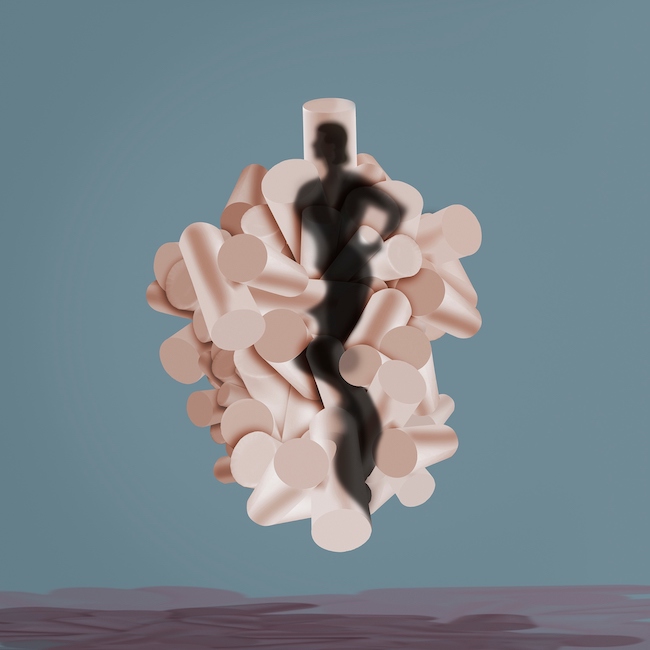
Ma il suo istinto espressivo gli richiedeva di concentrarsi anche su un mondo meno commerciale, meno finalizzato alla comunicazione, per tendere verso una dimensione più artistica attraverso la quale dare manifestare il suo pensiero filosofico, dare sfogo alla sua sensibilità che invece doveva trattenersi nel campo strettamente professionale. Comincia pertanto a utilizzare il mezzo che più profondamente conosce, il computer, per delineare un suo stile personale, scegliendo la Digital Painting a cui dà una precedente struttura attraverso il disegno che poi, una volta editato, completa con dei ritocchi in acrilico.
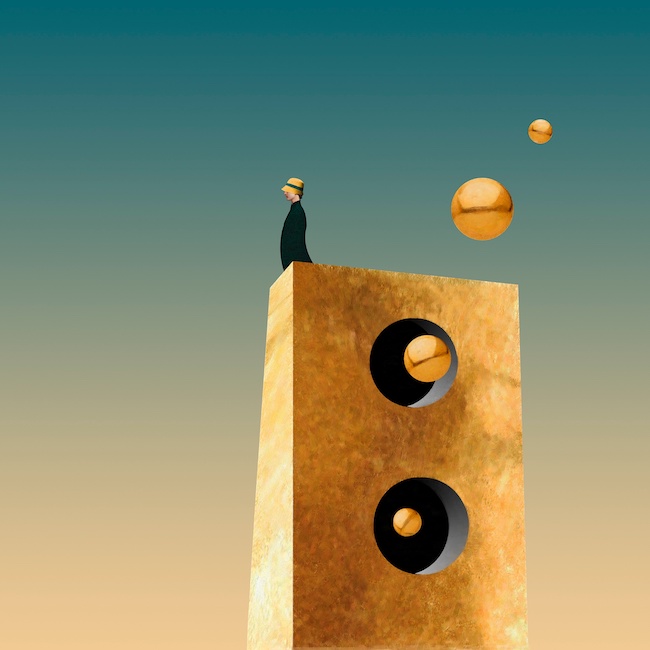
Indiscutibilmente Campanini appartiene alla Metafisica grazie alla quale può far emergere le sue riflessioni sull’essere umano, un campo che conosce proprio in virtù di quell’analisi necessaria ai creativi pubblicitari per comprendere i gusti del pubblico e le direzioni da intraprendere per rendere appetibile un prodotto; il tema che più emerge dalle sue opere è quello della solitudine, dell’instabilità e delle insicurezze a cui la società contemporanea è costretta a far fronte, quella necessità di contare su se stessi per affrontare le avversità che inevitabilmente si succedono e che caratterizzano un percorso in cui l’essere si confonde con l’avere, in cui le maschere che si indossano tendono a costituire un’armatura, una personalità parallela che a volte viene scambiata per vera essenza, e dove la scelta se resistere o arrendersi può fare la differenza nella realtà futura che andrà a delinearsi.
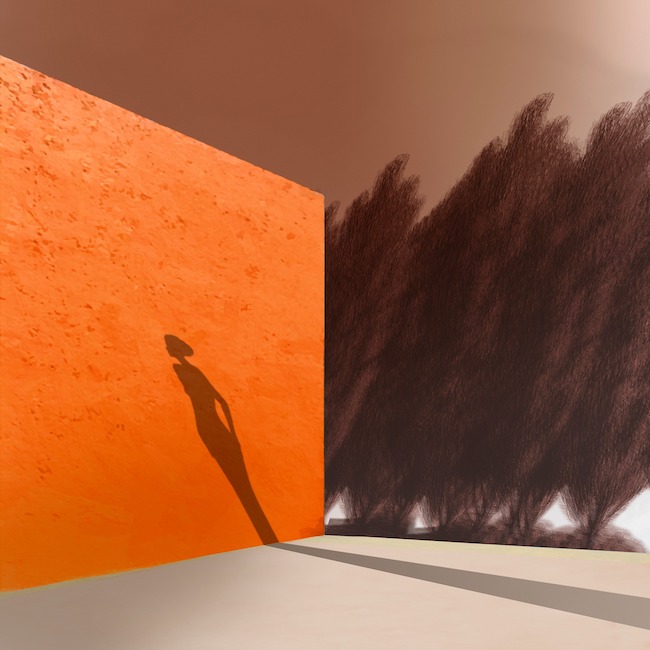
L’opera Resilient si lega esattamente a questo concetto, al punto di vista di Campanini sulla necessità di essere consapevoli dell’esigenza di trovare in qualche modo la forza per resistere a quel vento che piega gli alberi ma non la donna di cui mostra solo l’ombra, come se quel muro su cui si riflette fosse in realtà la proiezione della sua determinazione a oltrepassare le avversità senza lasciarsi sopraffare dagli eventi. Dunque l’artista evidenzia non tanto l’ostinazione ad andare contro una corrente troppo forte per essere arginata quanto invece la capacità di comprendere di doversi fermare anche solo un attimo fino al momento in cui la tormenta non sarà passata perché a quel punto diventerà facile oltrepassare il muro.

In AlterEgo sottolinea invece la coscienza dell’essere umano di non potere, e in fondo non volere, mostrarsi all’esterno nella totale trasparenza della propria natura perché spesso è necessario proteggersi, tutelare una sensibilità o semplicemente delle peculiarità caratteriali che non si è sicuri possano piacere; a quel punto l’immagine che si tende a manifestare diventa un guanto rassicurante al punto di non voler smettere di indossarlo. La protagonista dunque osserva e abbraccia l’altra sé quasi con gratitudine per permetterle di non scoprirsi completamente proteggendo o celando ciò che non desidera venga svelato.
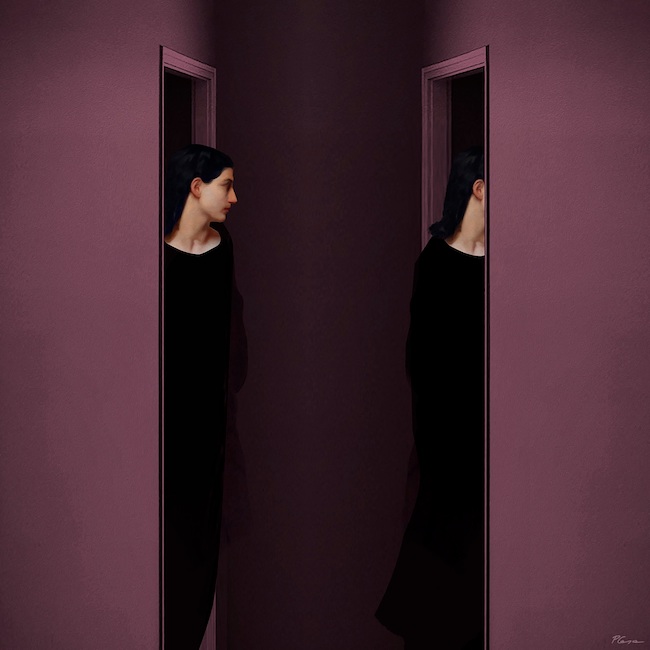
Nell’opera Parallel invece Campanini affronta il tema della realtà quantica, delle porte scorrevoli dell’esistenza che determinano percorsi completamente diversi, a volte persino opposti, e che non sono affidati alla casualità come tradizionalmente si è portati a credere, al contrario tutto dipende dalla scelta dell’individuo su un approccio all’esistenza che può essere più determinista o più fatalista, e questo può costituire la linea di demarcazione della direzione in cui la vita stessa va. La donna da un lato entra, dall’altro esce, sottolineando così le infinite possibilità che quelle due azioni differenti produrrebbero sul concatenamento di eventi subito seguente, o al contrario, sono il risultato delle scelte compiute in precedenza di cui le due possibilità costituiscono l’epilogo.
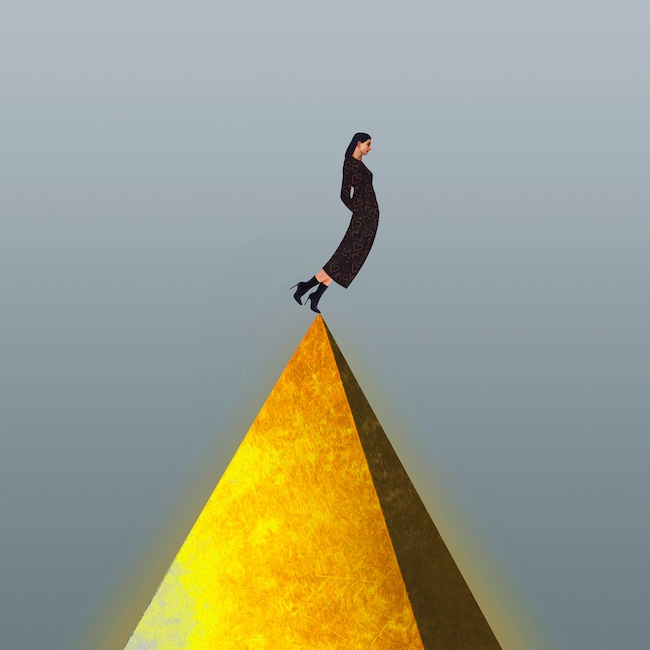
Piramide diviene forse il simbolo dell’instabilità del vivere attuale, quel dover costantemente trovare un equilibrio tra il possibile e l’impossibile, tra il voler arrivare alla meta e poi vacillare per non aver più un obiettivo da raggiungere, quel dover correre sul filo del rischio di poter perdere tutto da un momento all’altro cercando di mantenere invece quel tutto che costituisce la sicurezza, la base alla quale non è possibile fare a meno di aggrapparsi. Eppure la donna non appare spaventata, non sembra aver paura di cadere, al contrario sembra essere a suo agio in quell’equilibrismo esistenziale che probabilmente considera come parte imprescindibile di un percorso senza il quale niente avrebbe senso. Ecco dunque che l’individuo contemporaneo emerge con tutta la sua forza, non più gridata e affermata bensì ricavata proprio tra le pieghe delle proprie insicurezze e della mancanza di stabilità tipica della società attuale.
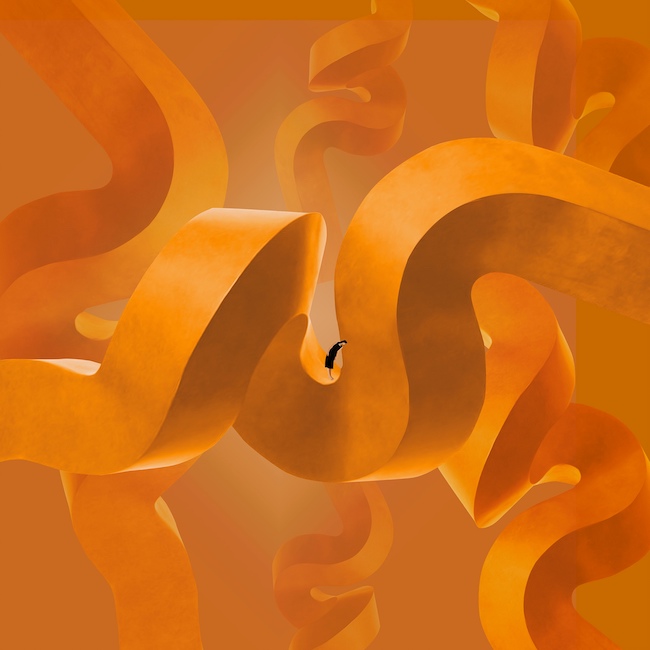
Piero Campanini, che per sua scelta professionale edita le sue opere solo su carta cotone di tipo museale montando l’originale su cornice a cui fa seguire cinque copie numerate e certificate senza cornice, ha all’attivo diverse mostre personali a Bologna, Como, Milano e ha partecipato a collettive a Milano, a Como e a Madrid.
PIERO CAMPANINI-CONTATTI
Email: pcampa24@gmail.com
Sito web: https://www.pierocampanini.com/
Facebook: https://www.facebook.com/pierocampaniniarte/
Linkedin: https://www.linkedin.com/in/piero-campanini-221a8615/
Instagram: https://www.instagram.com/piero_campanini/
The instability and uncertainty of contemporary life in the Metaphysical Digital Painting of Piero Campanini
In today’s artistic journey, have taken over a number of techniques that are not strictly pictorial, not in the classical sense of the term, but which have not only broadened the point of view of those involved thanks to the courage and intuition of a number of creative artists, but have also succeeded in instilling new lymph and new openness towards experimentation and further evolutions of expressive language that are functional to discovering how far previously well-delineated boundaries can be broken down to generate something new and of high value. The artist I am going to talk about today arrives at his current style after a path that has allowed him to measure himself with multiple communicative and creative approaches, as a result of which he has succeeded in elaborating his own imprint of suggestive charm.
The resistance of traditional artistic circles to the innovations that inevitably characterised and took place during the 20th century, have always had to reckon with the determination of artists to pursue those paths capable of carrying out the stylistic, conceptual and expressive revolution that has never been able to be stemmed by previous rules. Already the Fauves provoked a scandal in cultural circles with their bestial, aggressive, strong colours, so much as Salvador Dali’s immoral and perverse Surrealism met with opposition from the well-wishers of the early 20th century, before the whole world was conquered by its very dimension of nightmares and restlessness. And again Abstract Expressionism was rejected by the Metropolitan Museum of Art because it was not deemed worthy of being part of the great 1950 exhibition dedicated to contemporary American art. So when two mathematicians and programmers, Ben Laponsky and Manfred Frank, inspired by the constructivist and rationalist theories of the Bauhaus, gave life to what was then called Computer Art through which they were able to create graphic forms and lines from simple fractals, comprehensible hostility was generated from the academic world because it was unable to understand how many and what openings that particular type of approach would allow; however, the process of modernising art had already started and materialised with Op Art, Kinetic Art, and Dadaism, so creative contamination could not but continue to adapt to the new technological discoveries that characterised the most dynamic century in modern history.
Despite the appreciation of large groups of admirers, Digital Art struggled to gain the same consideration it had the more classical approach because it was thought to be accessible to a larger number of creatives who did not need to have an artistic background. The progress of technology and the advent of more sophisticated tools in computers broadened the possibilities of realisation, gradually requiring a more specific aptitude and an innate artistic talent, thus allowing many to choose this type of technique, refining it on the basis of their expressive inclination and sometimes mixing it with more traditional methods. Currently, Digital Art is divided into two main strands, Pixel Art and Digital Painting, which are applied both in the advertising and graphics sector and in the more strictly specific art sector. Piero Campanini from Milan has a long career behind him, during which he has progressed from drawing comic strips to advertising illustration and on to the communication of mass market products for television, first as an art director and then by founding his own creative boutique in the field of advertising. But his expressive instinct also required him to focus on a less commercial world, less aimed at communication, in order to tend towards a more artistic dimension through which he could manifest his philosophical thought, give vent to his sensitivity that instead had to remain in the strictly professional field. He therefore began to use the medium he knew best, the computer, to outline his personal style, choosing Digital Painting to which he gave a previous structure through drawing, which he then completed with retouches in acrylics once edited.
Unquestionably, Campanini belongs to the Metaphysical world, thanks to which he can bring out his reflections on the human being, a field that he knows precisely by virtue of that analysis necessary for advertising creatives to understand the public’s tastes and the directions to take in order to make a product appealing; the theme that most emerges from his artworks is that of loneliness, instability and insecurities that contemporary society is forced to face, that need to rely on oneself to face the adversities that inevitably occur and that characterise a path where being is confused with having, where the masks one wears tend to constitute an armour, a parallel personality that is sometimes mistaken for true essence, and where the choice of whether to resist or surrender can make the difference in the future reality that will emerge. The work Resilient ties in exactly with this concept, with Campanini’s point of view on the consciousness to be aware of the need to somehow find the strength to resist that wind that bends trees but not the woman whose shadow it only shows, as if that wall on which it is reflected was actually the projection of her determination to overcome adversity without letting herself be overwhelmed by events. Thus the artist emphasises not so much the obstinacy of going against a current too strong to be stemmed as the ability to realise that one must stop even for a moment until the storm has passed, because at that point it will become easy to get over the wall. In AlterEgo he emphasises the human being’s awareness of not being able, and basically not wanting, to show oneself to the outside world in the total transparency of one’s nature because it is often necessary to protect oneself, to protect a sensitivity or simply character traits that one is not sure one might like; at that point, the image that one tends to manifest becomes a reassuring glove to the point of not wanting to stop wearing it. The protagonist therefore observes and embraces her other self almost with gratitude to allow her not to reveal herself completely by protecting or concealing what she does not wish to be revealed.
In the artwork Parallel, on the other hand, Campanini tackles the theme of quantum reality, of the sliding doors of existence that determine completely different paths, sometimes even opposing ones, and that are not entrusted to randomness as one is traditionally led to believe, on the contrary everything depends on the individual’s choice of an approach to existence that can be more determinist or more fatalist, and this can constitute the demarcation line of the direction in which life itself goes. The woman on one side enters, on the other leaves, thus emphasising the infinite possibilities that those two different actions would produce on the chain of events immediately following, or on the contrary, are the result of the choices made previously of which the two possibilities constitute the epilogue. Pyramid perhaps becomes the symbol of the instability of present-day living, that having to constantly find a balance between the possible and the impossible, between wanting to reach the goal and then wavering because there is no longer a goal to be reached, that having to run on the edge of the risk of losing everything at any moment while trying to maintain that all that constitutes security, the base to which one cannot help but cling. Yet the woman does not appear frightened, she does not seem afraid of falling, on the contrary, she seems to be at ease in that existential balancing act that she probably considers to be an indispensable part of a path without which nothing would make sense. Here, then, the contemporary individual emerges with all his strength, no longer shouted and affirmed but drawn precisely from within the folds of his own insecurities and the lack of stability typical of today’s society. Piero Campanini, who by his professional choice edits his artworks only on museum-quality cotton paper by mounting the original on a frame followed by five numbered and certified copies without frames, has several solo exhibitions to his credit in Bologna, Como and Milan and has taken part in group exhibitions in Milan, Como and Madrid.













